Plant Science Research Weekly: July 1, 2022
Circadian clock component CCA1 is a transcriptional regulator of ABA-mediated abiotic stress tolerance in rice
 In rice, the circadian clock component gene Circadian Clock Associated 1 (OsCCA1) regulates flowering and nitrogen use efficiency. CCA1 is a MYB family transcription factor that follows a rhythmic expression pattern. Wei et al. confirmed the role of CCA1as a key hub in coordinating plant growth and abiotic stress adaptation. Transcript abundance of OsCCA1 was repressed by salt and drought stresses. Among the 692 target genes bound by CCA1 identified in DNA-affinity purification (DAP)-seq library, components of ABA signaling including clade A PP2cs and bZIP46 were particularly enriched. It was also confirmed that OsCCA1 could bind to the promoter regions of OsPP108 and bZIP46 and activate their expression. The Oscca1 mutants were short in stature and hypersensitive to salt and osmotic stresses, with reduced survival and reduced yield. Oscca1 mutants were also hypersensitive to ABA and showed comparatively lower survival than wild type after two weeks of ABA treatment. Thus, it is clear that under stress conditions OsCCA1 negatively modulates ABA signaling and by promoting the expression of negative regulators. The superior alleles or haplotypes of CCA1 and other circadian clock components are important targets for multiple stress tolerance in crop plants. (Summary by Lekshmy Sathee @lekshmysnair) Plant Physiol. 10.1093/plphys/kiac196
In rice, the circadian clock component gene Circadian Clock Associated 1 (OsCCA1) regulates flowering and nitrogen use efficiency. CCA1 is a MYB family transcription factor that follows a rhythmic expression pattern. Wei et al. confirmed the role of CCA1as a key hub in coordinating plant growth and abiotic stress adaptation. Transcript abundance of OsCCA1 was repressed by salt and drought stresses. Among the 692 target genes bound by CCA1 identified in DNA-affinity purification (DAP)-seq library, components of ABA signaling including clade A PP2cs and bZIP46 were particularly enriched. It was also confirmed that OsCCA1 could bind to the promoter regions of OsPP108 and bZIP46 and activate their expression. The Oscca1 mutants were short in stature and hypersensitive to salt and osmotic stresses, with reduced survival and reduced yield. Oscca1 mutants were also hypersensitive to ABA and showed comparatively lower survival than wild type after two weeks of ABA treatment. Thus, it is clear that under stress conditions OsCCA1 negatively modulates ABA signaling and by promoting the expression of negative regulators. The superior alleles or haplotypes of CCA1 and other circadian clock components are important targets for multiple stress tolerance in crop plants. (Summary by Lekshmy Sathee @lekshmysnair) Plant Physiol. 10.1093/plphys/kiac196
Single seeds exhibit transcriptional heterogeneity during secondary dormancy induction
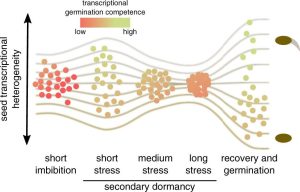 Secondary dormancy (SD) of seeds is a natural strategy that allows survival of the plant in environments with unfavourable climatic conditions. However, in Arabidopsis, a variance of dormancy depth in between identical seeds can be explained by population-based threshold models. This single-seed variability relies on the differences in oxygen consumption, hormone levels and sensitivity, and endo-β-mannanase enzymatic activity. In particular, the single-seed response to SD has been less studied than the response to primary dormancy. In this work, Krzyszton et al., describe a protocol for single-seed transcriptomic analysis to show differences between genetically identical seeds that are subjected to the same stress. The authors subjected Arabidopsis thaliana seeds to high temperature and darkness to induce SD. They observed that the treatment generates the same transcriptomic drop during the stress in all the seedlings. However, transcriptomic differences in the recovery step were observed between the germinating seeds and the ones that remained in SD. Seed heterogeneity is a well-known phenomenon with several studies addressing its importance. Thus, this article addresses the problems derived from seed heterogeneity by the development of the single-seed RNA-Seq method. (Summary by Eva Maria Gomez Alvarez, @eva_ga96). Plant Physiol. 10.1093/plphys/kiac265
Secondary dormancy (SD) of seeds is a natural strategy that allows survival of the plant in environments with unfavourable climatic conditions. However, in Arabidopsis, a variance of dormancy depth in between identical seeds can be explained by population-based threshold models. This single-seed variability relies on the differences in oxygen consumption, hormone levels and sensitivity, and endo-β-mannanase enzymatic activity. In particular, the single-seed response to SD has been less studied than the response to primary dormancy. In this work, Krzyszton et al., describe a protocol for single-seed transcriptomic analysis to show differences between genetically identical seeds that are subjected to the same stress. The authors subjected Arabidopsis thaliana seeds to high temperature and darkness to induce SD. They observed that the treatment generates the same transcriptomic drop during the stress in all the seedlings. However, transcriptomic differences in the recovery step were observed between the germinating seeds and the ones that remained in SD. Seed heterogeneity is a well-known phenomenon with several studies addressing its importance. Thus, this article addresses the problems derived from seed heterogeneity by the development of the single-seed RNA-Seq method. (Summary by Eva Maria Gomez Alvarez, @eva_ga96). Plant Physiol. 10.1093/plphys/kiac265
PIMT and ABI-TFs cascade mediates desiccation tolerance and longevity in rice seeds
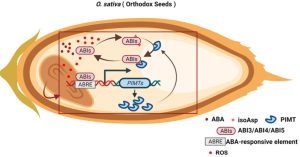 Seeds acquire desiccation tolerance (DT) during maturation to survive extreme water loss and remain viable for a prolonged time in dry conditions (longevity). The ABA INSENSITIVE (ABI) transcription factors (TFs) (ABI3, ABI4, ABI5) regulate DT and play essential roles during seed germination. Therefore, these TFs must be functionally protected during seed desiccation. Recalcitrant seeds are sensitive to desiccation, while orthodox seeds possess a remarkable ability to tolerate desiccation. However, the mechanism that makes orthodox seeds desiccation-tolerant is not clear. By comparing two rice varieties contrasting for seed desiccation tolerance (Oryza sativa and O. coarctata), Kamble and Majee revealed that PROTEIN L-ISOASARTYL METHYLTRANSFERASE (PIMT) an enzyme that repairs abnormal isoaspartyl (isoAsp) residues in proteins, plays an essential role during DT acquisition. Reduced PIMT activity correlates with a reduced DT in recalcitrant seeds. The authors identified that PIMT expression is regulated by the coordinated action of ABA and ABI TFs. While ABA levels are stable in the two species, ABI-TF-dependent ABA signalling was found severely affected in recalcitrant seeds during maturation. Furthermore, PIMT maintains and positively regulates the activity of ABI TFs by repairing abnormal isoAsp residues during seed desiccation. In conclusion, unlike recalcitrant seeds, orthodox seeds have high PIMT activity due to well-expressed ABI TFs. This PIMT activity protects and facilitates the activity of ABI TFs by controlling the accumulation of detrimental isoAsp residues and eventually governs orthodox seeds to be desiccation-tolerant. (Summary by Subodh Verma @subodhshanky) Development 10.1242/dev.200600
Seeds acquire desiccation tolerance (DT) during maturation to survive extreme water loss and remain viable for a prolonged time in dry conditions (longevity). The ABA INSENSITIVE (ABI) transcription factors (TFs) (ABI3, ABI4, ABI5) regulate DT and play essential roles during seed germination. Therefore, these TFs must be functionally protected during seed desiccation. Recalcitrant seeds are sensitive to desiccation, while orthodox seeds possess a remarkable ability to tolerate desiccation. However, the mechanism that makes orthodox seeds desiccation-tolerant is not clear. By comparing two rice varieties contrasting for seed desiccation tolerance (Oryza sativa and O. coarctata), Kamble and Majee revealed that PROTEIN L-ISOASARTYL METHYLTRANSFERASE (PIMT) an enzyme that repairs abnormal isoaspartyl (isoAsp) residues in proteins, plays an essential role during DT acquisition. Reduced PIMT activity correlates with a reduced DT in recalcitrant seeds. The authors identified that PIMT expression is regulated by the coordinated action of ABA and ABI TFs. While ABA levels are stable in the two species, ABI-TF-dependent ABA signalling was found severely affected in recalcitrant seeds during maturation. Furthermore, PIMT maintains and positively regulates the activity of ABI TFs by repairing abnormal isoAsp residues during seed desiccation. In conclusion, unlike recalcitrant seeds, orthodox seeds have high PIMT activity due to well-expressed ABI TFs. This PIMT activity protects and facilitates the activity of ABI TFs by controlling the accumulation of detrimental isoAsp residues and eventually governs orthodox seeds to be desiccation-tolerant. (Summary by Subodh Verma @subodhshanky) Development 10.1242/dev.200600
Oxidant system and ABA drive germination in seeds of palm species with differences in desiccation tolerance ($)
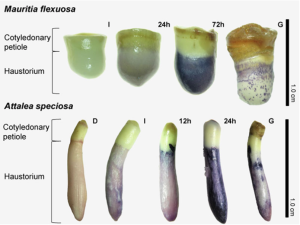 Palms are a taxonomically and ecologically diverse group. This wide variety is also reflected in their seeds, with their species showing all combinations of dormancy and desiccation tolerance behaviors. Yet, comparative studies of their germination physiology are relatively scarce. In this paper, Santos and colleagues evaluate i) the temperature requirements and ii) ABA, ROS and antioxidant system dynamic of two species with dormant seeds but contrasting desiccation tolerance: Mauritia flexuosa (desiccation-sensitive) and Attalea speciosa (tolerant). The species shared several features, including similar antioxidant system enzyme activity patterns and a conspicuous production of O2– in the haustorium after dormancy break. Still, M. flexuosa germinated at a narrower range of temperatures than A. speciosa; and even under optimal conditions, its germination was significantly slower. Moreover, H2O2 and ABA levels were higher in M. flexuosa and did exhibit a considerable decrease during germination. Antioxidant enzyme activity in this species was also ten times higher. These differences were particularly notable for ascorbate peroxidase activity, which was practically inexistent in A. speciosa. As a result, this research provides exciting insights into the physiological differences between species of this highly diverse family. (Summary by Carlos A. Ordóñez-Parra @caordonezparra) Seed Sci. Res. 10.1017/S0960258522000095
Palms are a taxonomically and ecologically diverse group. This wide variety is also reflected in their seeds, with their species showing all combinations of dormancy and desiccation tolerance behaviors. Yet, comparative studies of their germination physiology are relatively scarce. In this paper, Santos and colleagues evaluate i) the temperature requirements and ii) ABA, ROS and antioxidant system dynamic of two species with dormant seeds but contrasting desiccation tolerance: Mauritia flexuosa (desiccation-sensitive) and Attalea speciosa (tolerant). The species shared several features, including similar antioxidant system enzyme activity patterns and a conspicuous production of O2– in the haustorium after dormancy break. Still, M. flexuosa germinated at a narrower range of temperatures than A. speciosa; and even under optimal conditions, its germination was significantly slower. Moreover, H2O2 and ABA levels were higher in M. flexuosa and did exhibit a considerable decrease during germination. Antioxidant enzyme activity in this species was also ten times higher. These differences were particularly notable for ascorbate peroxidase activity, which was practically inexistent in A. speciosa. As a result, this research provides exciting insights into the physiological differences between species of this highly diverse family. (Summary by Carlos A. Ordóñez-Parra @caordonezparra) Seed Sci. Res. 10.1017/S0960258522000095
Plants’ PHR2-controlled phosphate starvation response regulates fungal symbiosis in rice
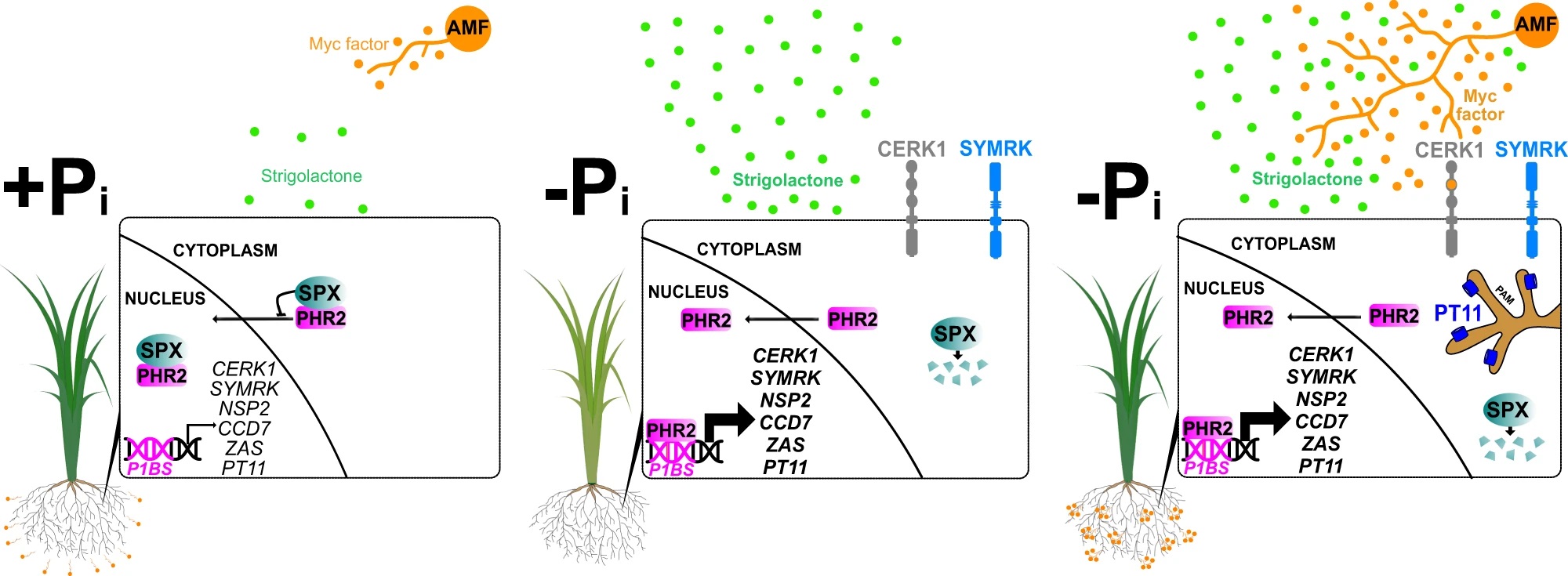 Plants’ interaction with microbes in the rhizosphere affects their health and productivity. Plant-arbuscular mycorrhiza (AM) fungi symbiosis is associated with almost 80% of land plants. The fungi provide phosphate, stress tolerance, and firmness to the soil in exchange for carbon. While low phosphate promotes AM symbiosis, the mechanistic basis of phosphate-dependent AM development remains obscure. Das et al. demonstrated the role of a MYB transcription factor, Phosphate Starvation Response (PHR) protein in rice that regulates AM development. They found that PHR2 is highly expressed in AM-associated plant tissues and its mutation results into decrease in colonization of the root cortex. Global transcriptomic and chromatin immunoprecipitation studies identified the putative PHR2 targets associated with pre-contact signaling, root colonization, and AM function. Additionally, the study of PHRs in the model legume (L. japonicas) showed that the PHR-mediated AM development might be conserved across the angiosperms. The findings of this study provide important insights into the regulation of AM by the plant phosphate status. (Summary by Chandan Kumar Gautam @chandan_gautam) Nature Comms. 10.1038/s41467-022-27976-8
Plants’ interaction with microbes in the rhizosphere affects their health and productivity. Plant-arbuscular mycorrhiza (AM) fungi symbiosis is associated with almost 80% of land plants. The fungi provide phosphate, stress tolerance, and firmness to the soil in exchange for carbon. While low phosphate promotes AM symbiosis, the mechanistic basis of phosphate-dependent AM development remains obscure. Das et al. demonstrated the role of a MYB transcription factor, Phosphate Starvation Response (PHR) protein in rice that regulates AM development. They found that PHR2 is highly expressed in AM-associated plant tissues and its mutation results into decrease in colonization of the root cortex. Global transcriptomic and chromatin immunoprecipitation studies identified the putative PHR2 targets associated with pre-contact signaling, root colonization, and AM function. Additionally, the study of PHRs in the model legume (L. japonicas) showed that the PHR-mediated AM development might be conserved across the angiosperms. The findings of this study provide important insights into the regulation of AM by the plant phosphate status. (Summary by Chandan Kumar Gautam @chandan_gautam) Nature Comms. 10.1038/s41467-022-27976-8
Inclusive restoration: Ten recommendations to support LGBTQ+ researchers in restoration science
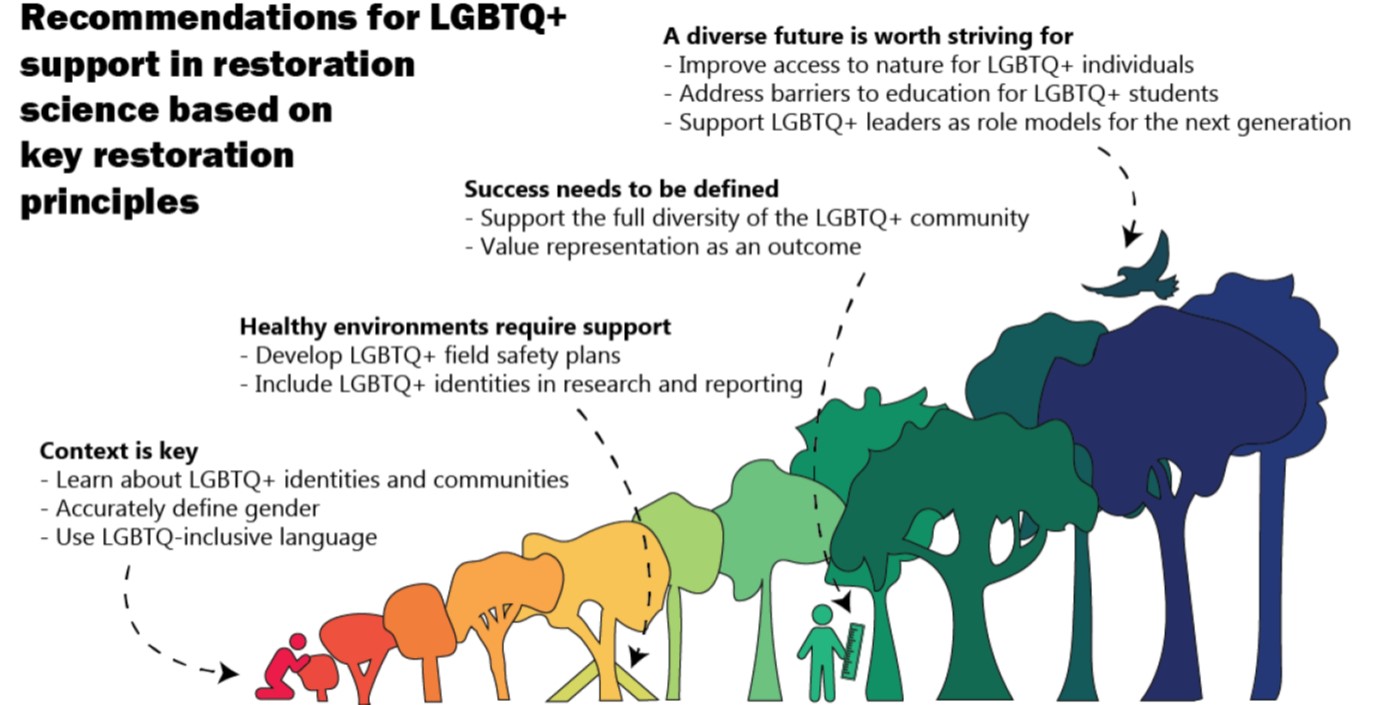 Restoration ecologists seek to repair damaged environments, and as Toone et al. write, “the same principles that shape ecosystem restoration also provide a blueprint for cultivating inclusion in science”. Here, a group of mostly early-career restoration ecologists use their professional lenses and provide ten recommendations to support LGBTQ+ researchers (these are specified towards but not limited to restoration science). Their recommendations include using appropriate language, support healthy environments, and strive for diverse environments. (Summary by Mary Williams @PlantTeaching) Restoration Ecology 10.1111/rec.13743
Restoration ecologists seek to repair damaged environments, and as Toone et al. write, “the same principles that shape ecosystem restoration also provide a blueprint for cultivating inclusion in science”. Here, a group of mostly early-career restoration ecologists use their professional lenses and provide ten recommendations to support LGBTQ+ researchers (these are specified towards but not limited to restoration science). Their recommendations include using appropriate language, support healthy environments, and strive for diverse environments. (Summary by Mary Williams @PlantTeaching) Restoration Ecology 10.1111/rec.13743



